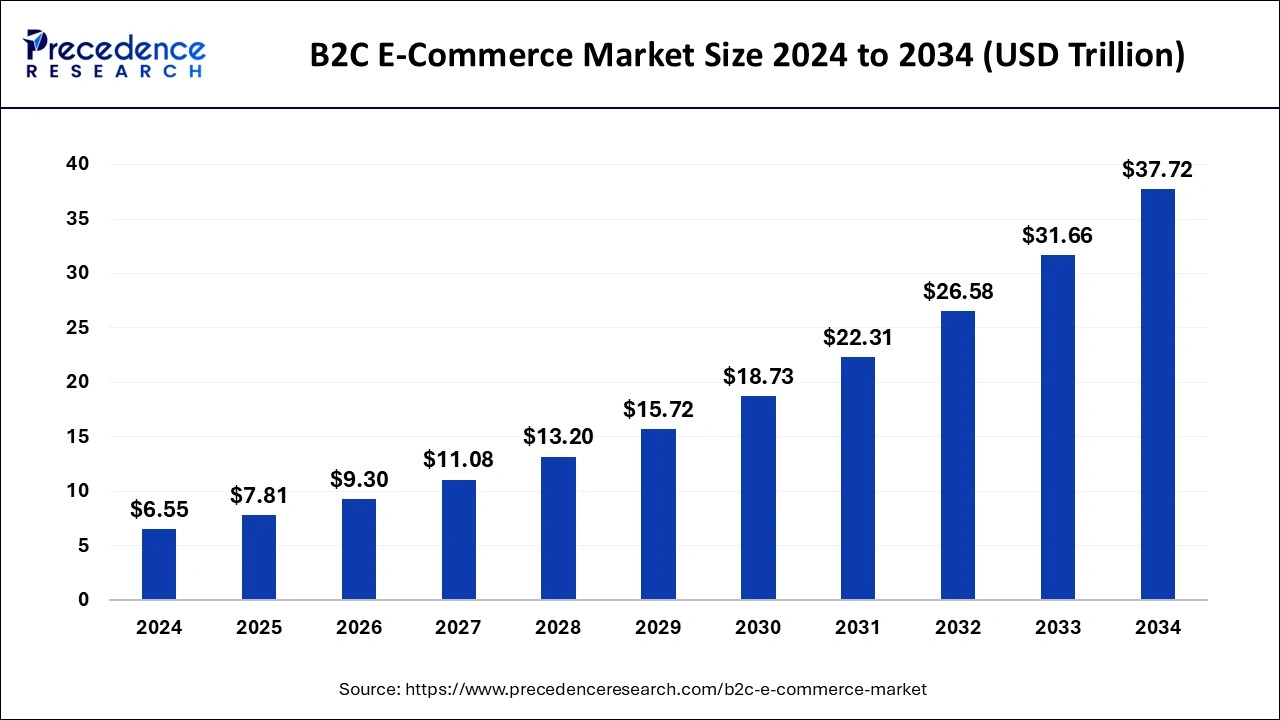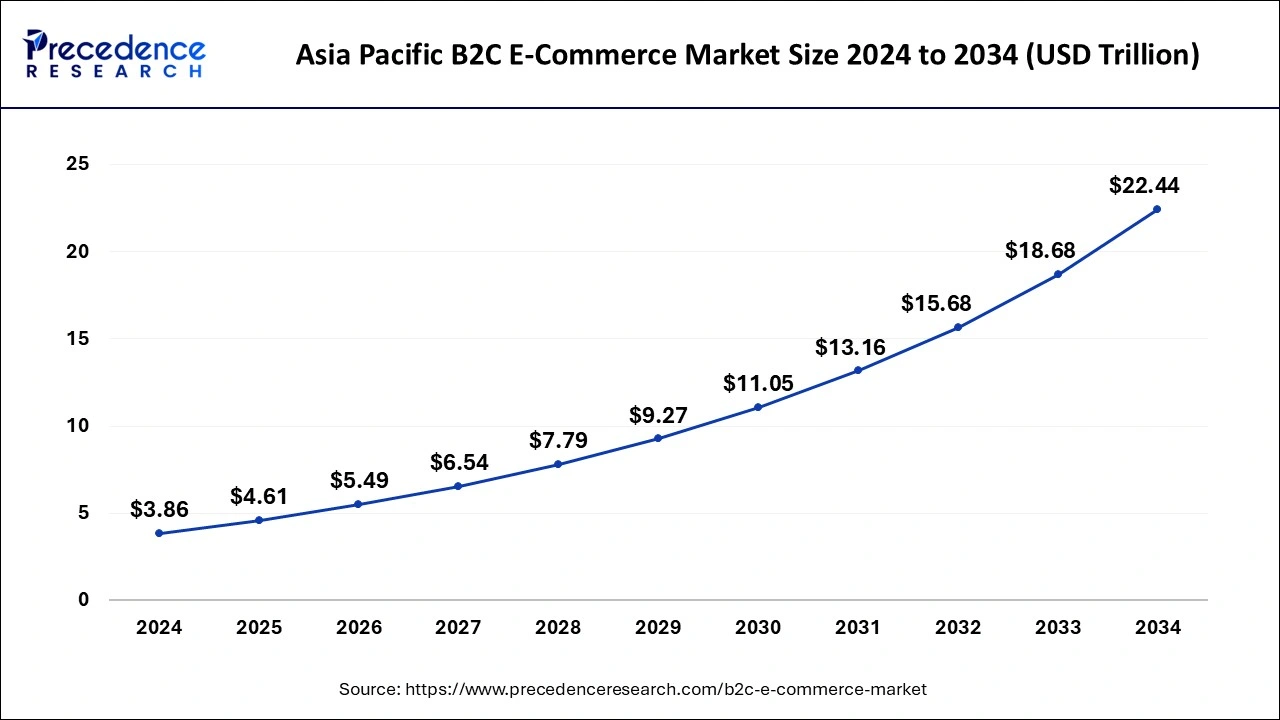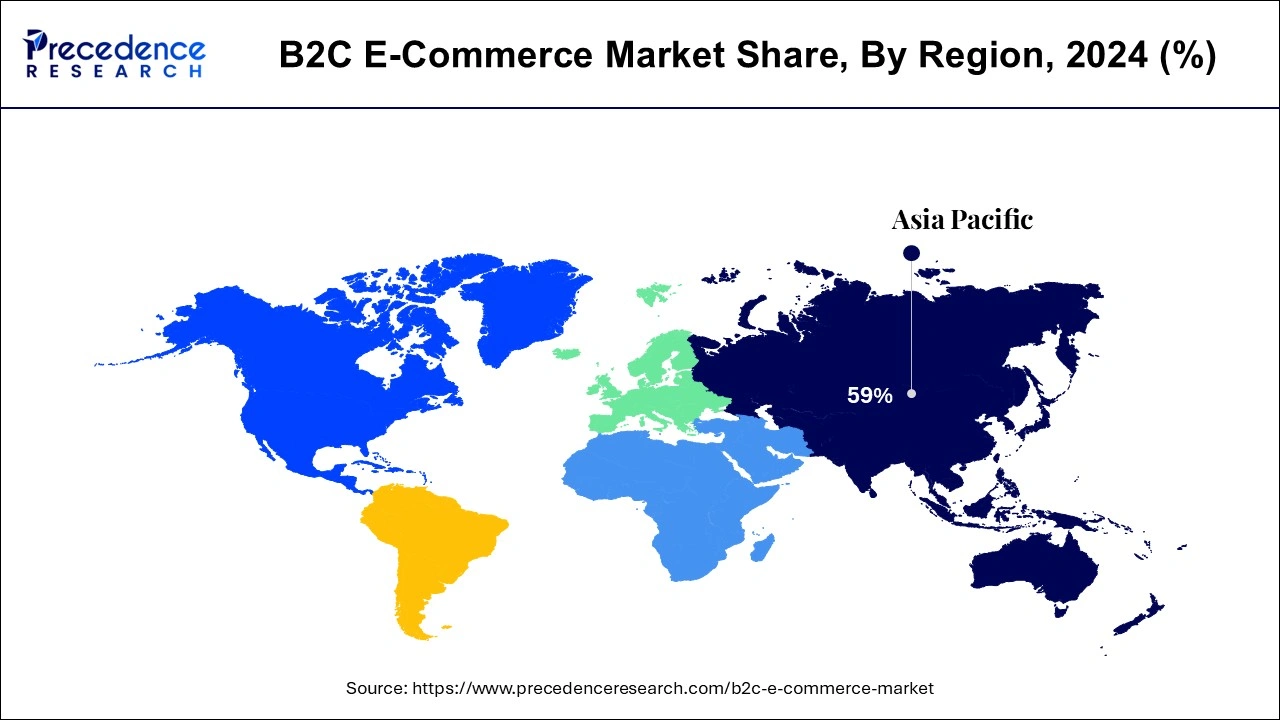What is the B2C E-Commerce Market Size?
The global b2c e-commerce market size is calculated at USD 7.81 trillion in 2025 and is predicted to increase from USD 9.30 trillion in 2026 to approximately USD 37.72 trillion by 2034, growing at a CAGR of 19.13% from 2025 to 2034.

B2C E-Commerce Market Key Takeaways
- Asia Pacific dominated the global market with the largest market share of 59% in 2024.
- North America is projected to expand at the notable CAGR during the forecast period.
- By type, the b2c retailers segment contributed the highest market share in 2024.
- By type, the classifieds segments is estimated to be the fastest-growing segment during the forecast period.
- By application, the clothing and footwear segment has held the largest market share in 2024.
- By application, the consumer electronics segments is predicted to be the fastest-growing segment during the forecast period.
What are the Growth Factors of the B2C E-Commerce Market?
The global b2c e-commerce market is driven by several factors such as rising disposable income, rising penetration of internet, rising adoption of smartphones, and growing per capita income across the globe. The proliferation of technological advancements has boosted the adoption of smartphones, which has allowed the e-commerce platforms to increase its reach across the every corner of the world. Furthermore, the rising investments in the development of the IT and telecommunications infrastructure has improved the access to the internet and the number of internet users grew rapidly in the past few years across the globe. According to the International Telecommunication Union, there were around 4.9 billion (63% of the global population) internet users by the end of 2021. This number was 4.1 billion in 2019 and it grew rapidly by 782 million in 2 years. Thus the rapid penetration of the internet is significantly boosting the growth of the b2c e-commerce market. Moreover, the surging use of the social media across the globe is playing a crucial role in the revenue generation of the e-commerce platforms. The availability of top e-commerce players such as Amazon, Wal-Mart, eBay, and Flipkart that offers a huge variety of products and brands from the convenience of home to the shoppers along with huge discounts and offers and easy payment, replace, and refund policies has significantly driven the market growth in the past decade
The busy and hectic life schedule of the consumers is a major growth factor for the b2c e-commerce market. Convenience offered by the e-commerce has encouraged the market development and growth. Moreover, the aggressive digital marketing and social media marketing strategies adopted by the key players has contributed towards the market growth. The ease and conveniences associated with online shopping, huge discounts and offers, easy payment options, door step home delivery, easy refund and replacement options, and one-day delivery are some of the important features that has made online shopping popular among the customers. Furthermore, the rapid shift towards m-commerce as most of the user access to the internet through smartphones is a major factor behind the growth of the online shopping. The recent outbreak of the COVID-19 pandemic has significantly boosted the adoption of the e-commerce among the consumers for buying medicines, groceries, and other products. The rapidly growing number of online pharmacies across the globe is expected to boost the market growth significantly in the forthcoming future. Furthermore, the integration of the online shopping and the online payment platforms is supplementing the growth of the market. For instance, Amazon allows payment and shopping through a single application. The online payment apps like Google Pay and Paytm offers huge discounts and cashbacks with online shopping, which has exponentially contributed towards the market growth.
B2C E-Commerce Market Outlook
- Industry Growth Overview: The B2C e-commerce sector is expected to increase rapidly from 2025 to 2030, energized by mobile-first consumers, quicker delivery options, and social commerce. The Asia-Pacific region will be the growth leader due to the increased prevalence of digital payments. North America will take the lead in omnichannel activities and personalized retail experiences through online shopping.
- Sustainability Trends: Green e-commerce operations have become more prevalent, as brands emphasize recyclable packaging, carbon-neutral logistics practices, and ethical sourcing. Large commerce operators like Amazon and Alibaba are enhancing their investment in more sustainable delivery fleets and renewable data centers to have a positive effect on consumer expectations for sustainable practices.
- Global Expansion: Global e-commerce operators are strengthening their foothold in emerging markets, such as India, Brazil, and Indonesia. Their boost in emerging markets departs from improved digital infrastructure, logistics network improvements, and hybridized payments to fit the consumer groups specific to each market.
- Key Investors: Venture capital and private equity are making big investments in AI-enabled retail and direct-to-consumer brands and logistics tech. Sequoia, SoftBank, and Tiger Global are investing heavily in businesses that scale, are able to leverage data-driven marketing, and/or innovate in cross-border commerce.
- Startup Ecosystem: There is a growing roster of startups that focus on niche categories like circular fashion, health supplements, and sustainable home goods. Companies, like Meesho (India) and ThredUp (US), are disrupting legacy retail using peer-to-peer selling and recommerce models.
Market Scope
| Report Coverage | Details |
| Market Size in 2025 | USD 7.81 Trillion |
| Market Size in 2026 | USD 9.30 Trillion |
| Market Size in 2034 | USD 37.72 Trillion |
| Growth Rate from 2025 to 2034 |
CAGR of 19.13% |
| Largest Market | Asia Pacific |
| Fastest Growing Market | North America |
| Base Year | 2024 |
| Forecast Period | 2025 to 2034 |
| Segments Covered | Type, Application, Brand Type, Device, Geography |
| Regions Covered | North America, Europe, Asia-Pacific, Latin America, and Middle East & Africa |
Type Insights
Based on the type, the b2c retailers segment accounted for a market share of over 99% and dominated the global b2c e-commerce market in 2024. The increasing urban population, rising volume of online transactions, and growing adoption of various online shopping platforms are the driving factors of this segment. Moreover, a rapid shift in the consumer behavior from traditional to online shopping, improved logistics, ease of doing business, and globalization of businesses are some of the factors that has driven the market growth.
On the other hand, the classifieds is estimated to be the most opportunistic segment during the forecast period. The rising mobile classified advertisements and low cost online advertisements are the growth drivers of this segment.
Application Insights
Based on the application, the clothing & footwear segment dominated the global b2c e-commerce market, garnering a market share of around 25% in 2024. The rapid popularity of the online clothing and footwear retailers across the globe has fueled the growth of this segment. The manufacturers of clothing and footwear are heavily investing in increasing their online presence. The online retailers of clothes provide wide variety of options, easy payment, home delivery, and easy refund and replacement. The user friendly website and easy navigation allows the customers to easily find the desire product and brands, which favors the growth of this segment.
On the other hand, consumer electronics is expected to be the fastest-growing segment during the forecast period. The increased demand for the latest and innovative consumer electronics like smart TV, refrigerator, fans, and air conditioners across the globe coupled with the easy availability of products on online websites and higher product acceptance are the major factors that may be held responsible for the growth of the consumer electronics segment.
Key Market Developments
- In March 2018, Amazon partnered with FICCI, a non-profit organization. This partnership aimed at facilitating the exporters in India to grow their international sales.
The B2C e-commerce market is highly fragmented with the presence of several local and global companies. These market players are striving to gain higher market share by adopting strategies, such as investments, partnerships, and acquisitions & mergers. Companies are also spending on the development of improved products. Moreover, they are also focusing on maintaining competitive pricing.
Regional Insights
Asia Pacific B2C E-Commerce Market Size and Growth 2025 to 2034
The Asia Pacific b2c e-commerce market size is exhibited at USD 4.61 trillion in 2025 and is projected to be worth around USD 22.44 trillion by 2034, growing at a CAGR of 19.25% from 2025 to 2034.

Asia Pacific garnered a market share of around 37% and dominated the global b2c e-commerce market in 2024. Asia Pacific is the home to the world's largest population. The strong economic growth in the emerging nations like China and India are the major drivers of the Asia pacific b2c e-commerce market. The rising industrialization, rising disposable income, rapidly growing urban population and rapid adoption of the smartphones among the population has boosted the market growth in this region. Moreover, the increased government investments in the development of infrastructure, banking systems, urbanization of rural areas, electrification of rural areas, and internet connectivity are the several factors that has driven the market growth.
Why is the Asia Pacific region so dominant in the B2C e-commerce market?
The Asia Pacific region is the dominant region in the global B2C e-commerce market due to its vast base of internet users, a rapidly growing mobile penetration, and the development of a digital payments ecosystem. The region has more than 2.5 billion internet users, which creates a market capable of processing a high number of transactions, particularly since many of the economies are mobile first (e.g. India, Southeast Asia, China). With the advancement of logistics, digital wallets and a growing middle class, digital retail is booming.
China is vital to Asia Pacific's dominance in the B2C e-commerce sector. China has more than 850 million online shoppers, the most in the world, and its market is being driven by dominant tech platforms like Alibaba, JD.com, and Pinduoduo. Chinese consumers tend to prefer mobile shopping, with more than 70% of e-commerce transactions occurring on smartphones. Events such as Singles' Day generate billions of sales in one day, and are representative of China's hyper developed culture of e-commerce.

North America is estimated to grow at a steady rate throughout the forecast period. North America has the highest internet using population. Moreover, the higher disposable income and increased awareness regarding the various online platforms has propelled the market growth in this region. The Middle East and Africa is expected to be the second-fastest growing market owing to various factors such as rising penetration of internet, growing adoption of smartphones, rising disposable income, and rising adoption of e-commerce platforms.
What is driving North America to become the fastest growing region in the B2C E-commerce market?
North America is experiencing the fastest growth in B2C e-commerce growth globally and this is largely due to increased internet penetration, strong digital infrastructure, and changing consumer preferences. The U.S. leads the continent where at least 80% of internet users purchase online. Growth is largely due to mobile commerce, voice-enabled purchases, and demand for faster delivery.
Emerging technologies such as AI-based personalization and AR product previews improve the user experience. Also noted is the widespread use of digital wallets (e.g. Apple Pay, PayPal). Omnichannel strategies are also gaining traction; these are important as all retail continues to become a blend of the physical and digital to meet consumer expectations for convenience, speed, and engagement across all platforms.
Europe - The Smart Shopper's Market
Europe has enjoyed a strong presence in the B2C E-Commerce Market because of high levels of digital literacy, secure online payment options, and strict consumer protection laws. The opportunity for growth was pronounced through cross-border trade and interest in sustainable products across different parts of Europe.
The U.K. held the lead in e-commerce across Europe because of its highly advanced logistics, high levels of smartphone usage, and strong brands and retailers like ASOS and Tesco. UK consumers preferred convenience, fast delivery, and flexible payment options, which helped drive online sales each year.
Latin America - The New Frontier of Online Retail
Latin America began to see some rapid growth in e-commerce primarily due to improved access to the internet, accessibility of digital payments, and increased demand for mobile shopping. From increased trust levels to growing middle-class income levels, there were significant opportunities for regional and global players.
Brazil was the leading player in the Latin American market for e-commerce, thanks to high levels of online activity supported by major platforms like Mercado Livre. The Brazilian government also plays a role in developing the e-commerce market through policies supporting fintech as well as the modernization of logistics to enhance access and enable citizens to participate in digital commerce.
Middle East & Africa - The Emerging Digital Horizon
The Middle East and Africa region experienced significant e-commerce growth through the adoption of smartphones, rapid urbanization, and the growth of digital payments. The population of youth and influence from social media facilitated new possibilities for both new and established online businesses.
The United Arab Emirates led the regional market in part because of its solid infrastructure, high income levels, and added trust that is provided by online platforms like Noon and Amazon.ae. Furthermore, Government digital policies also aided in bolstering online trade and foreign investment.
B2C E-Commerce Market Companies
- Alibaba Group Holding Limited
- Amazon.com Inc.
- ASOS plc
- Booking Holdings Inc.
- eBay Inc.
- JD.com Inc.
- Macy's Inc.
- Makemytrip Limited
- Otto GmbH & Co KG
- Rakuten Inc.
- Walmart Inc.
Segments Covered in the Report
By Type
- Classifieds
- B2C Retailers
By Application
- Consumer Electronics
- Automotive
- Books & Stationery
- Clothing & Footwear
- Beauty & Personal Care
- Media & Entertainment
- Home Décor & Electronics
- Travel & Tourism
- Sports & Leisure
- Information & Technology
- Others
By Brand Type
- Single Brand
- Multi Brand
By Device
- PCs
- Smart Phone
- Tablet
- Others
By Geography
- North America
- Latin America
- Europe
- Asia-pacific
- Middle and East Africa
 Get a Sample
Get a Sample
 Table Of Content
Table Of Content